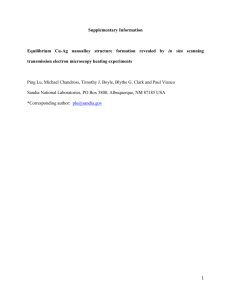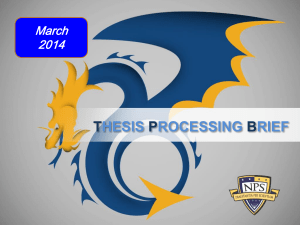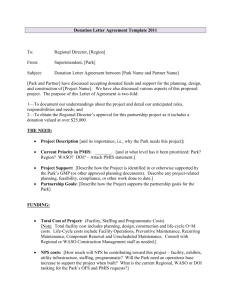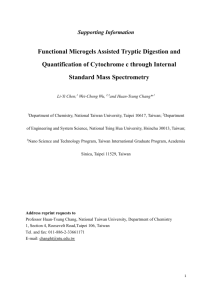Template for Electronic Submission to ACS Journals
advertisement
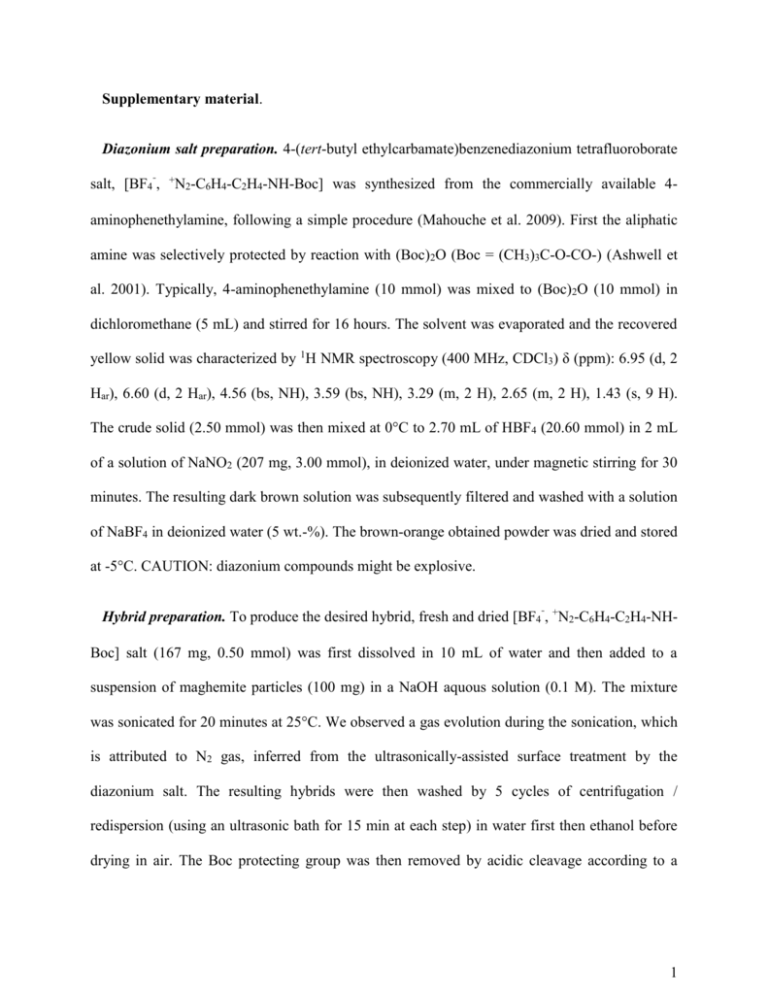
Supplementary material. Diazonium salt preparation. 4-(tert-butyl ethylcarbamate)benzenediazonium tetrafluoroborate salt, [BF4⁻, +N2-C6H4-C2H4-NH-Boc] was synthesized from the commercially available 4aminophenethylamine, following a simple procedure (Mahouche et al. 2009). First the aliphatic amine was selectively protected by reaction with (Boc)2O (Boc = (CH3)3C-O-CO-) (Ashwell et al. 2001). Typically, 4-aminophenethylamine (10 mmol) was mixed to (Boc)2O (10 mmol) in dichloromethane (5 mL) and stirred for 16 hours. The solvent was evaporated and the recovered yellow solid was characterized by 1H NMR spectroscopy (400 MHz, CDCl3) δ (ppm): 6.95 (d, 2 Har), 6.60 (d, 2 Har), 4.56 (bs, NH), 3.59 (bs, NH), 3.29 (m, 2 H), 2.65 (m, 2 H), 1.43 (s, 9 H). The crude solid (2.50 mmol) was then mixed at 0°C to 2.70 mL of HBF4 (20.60 mmol) in 2 mL of a solution of NaNO2 (207 mg, 3.00 mmol), in deionized water, under magnetic stirring for 30 minutes. The resulting dark brown solution was subsequently filtered and washed with a solution of NaBF4 in deionized water (5 wt.-%). The brown-orange obtained powder was dried and stored at -5°C. CAUTION: diazonium compounds might be explosive. Hybrid preparation. To produce the desired hybrid, fresh and dried [BF4⁻, +N2-C6H4-C2H4-NHBoc] salt (167 mg, 0.50 mmol) was first dissolved in 10 mL of water and then added to a suspension of maghemite particles (100 mg) in a NaOH aquous solution (0.1 M). The mixture was sonicated for 20 minutes at 25°C. We observed a gas evolution during the sonication, which is attributed to N2 gas, inferred from the ultrasonically-assisted surface treatment by the diazonium salt. The resulting hybrids were then washed by 5 cycles of centrifugation / redispersion (using an ultrasonic bath for 15 min at each step) in water first then ethanol before drying in air. The Boc protecting group was then removed by acidic cleavage according to a 1 typical procedure. Hybrids (20 mg) in dichloromethane (75 mL) were submitted to sonication for 5 minutes and trifluoroacetic acid (2 µL, 0.34 mmol) was added. The mixtured was then stirred (mechanically) for 4 hours and washed with dichloromethane by centrifugation / redispersion (4 cycles) before drying in air. Hybrid characterization. The structure of bare and functionalized maghemite NPs was analyzed using X-ray diffraction (XRD) using a Panalytical diffractometer equiped with a X’celerator detector and a Cobalt tube (λ = 1.7889 Å) in a θ-θ Bragg-Brentano reflexion configuration on the 15-95° angular range. Both recorded patterns match with the cubic iron Intensity (a.u.) oxide structure (Fig S1). (a) (b) 20 30 40 50 60 70 80 90 2Co (°) Fig S1. XRD pattern of hybrid NPs (a) compared to that of bare ones (b). Their microstructure was checked by Transmission Electron Microscopy (TEM) using a JEOL100-CX II microscope operating at 100 kV. The particle size was obtained from the recorded TEM images using SAISAM software (Microvision Instruments), calculating the surfaceaverage particle diameter through a statistical analysis performed by counting about 300 particles 2 considered to be spherical. The mean diameter was found to about 9.9 ± 0.5 nm for both hybrid and bare NPs. Fig S2. Size distribution of as-produced iron oxide NPs inferred from a statistical analysis of their TEM micrographs The superparamagnetic behavior of bare NPs was evidenced using a Quantum Design SQUID5T magnetometer by measuring the thermal variation of their magnetic susceptibility, (T), applying a dc magnetic field of 200 Oe, in the 2-330 K temperature range, under field cooling (FC) and zero field cooling (ZFC) conditions (Fig S3a) and the variation of their magnetization as a function of the magnetic field, M(H), between -5 and +5 T at 310K (Fig S3b). The recorded (T), and M(H) curves are given here after to illustrate that. 3 (a) 0.35 FC 0.25 -1 (emu.g .Oe ) 0.30 Bare NPs 200 Oe 0.20 -1 ZFC 0.15 0.10 0.05 0.00 0 50 100 150 200 250 300 350 T (K) (b) 100 Bare NPs 310 K -1 M (emu.g ) 50 0 -50 -100 -50000 -25000 0 25000 50000 H (Oe) Fig S3. Thermal variation of the dc-magnetic susceptibility of bare NPs recorded in FC and ZFC conditions under an applied field of 200 Oe (a) and the variation of their 310K-magnetization as a function of the magnetic field (b). Diazonium salt grafting was investigated through FTIR spectroscopy using KBr technique on a Bruker Equinox spectrometer working in the 4000-500 cm-1 energy range with a resolution of 4 cm-1. Besides Thermal analyses were performed with a Thermogravimetry/Differential Thermal Analyzer (TG/DTA) Setaram TGA92 apparatus from 20 to 1000°C (10°C/min) under air flow (80 mL/min). The recorded thermograms on hybrid and bare NPs (Fig S4) evidence 3 main mass 4 losses which are attributed to the departure of physisorbed water (below 100°C), the decomposition of organic residues, aryl or polyol (between 200 and 400°C) and the crystallographic transformation of the cubic ferric oxide into its hexagonal form (around 500°C), respectively, the last feature being explicitly observed only in bare NPs suggesting that aryl coating shift to higher temperature this transformation, as previously observed in other iron oxide hybrid NPs (see for instance El Mendili et al. 2015). (a) 0 4 (1) 2 0 -10 -2 -15 -4 (2) -20 -6 -25 HF (µV) TG (wt.-%) -5 -8 -10 -30 100 200 300 400 500 600 700 800 900 1000 T (°C) (b) 0 8 (1') 0 -8 -4 (2') -16 -6 HF (µV) TG (wt.-%) -2 -24 (3') -8 -32 -40 -10 100 200 300 400 500 600 700 800 900 1000 T (°C) Fig S4. Temperature dependence of the relative mass loss (TG) in black and the heat flow (HF) in blue of hybrid (a) and bare NPs (b) during their thermogravimetric analysis in air. The 5 horizontal dashed lines delimit the different main weight losses: (1) and (1’) for the endothermic physisorbed water departure, (2) and (2’) for the exothermic grafted aryl and polyol decomposition and (3’) for the exothermic crystallographic transformation from cubic to hexagonal structures. Finally, 57 Fe Mössbauer spectra of all the samples were also recorded using a 57 Co/Rh γ-ray source mounted on an electromagnetic drive and using a triangular velocity form. They were obtained at 300 and 77 K. The hyperfine structure was modeled by a least-squares fitting procedure involving Zeeman sextets and quadrupolar doublets composed of Lorentzian lines (the isomer shift values (δ) were referred to α-Fe. Ab initio modeling. The attachment of phenyl (C6H5) radical at the particle surface was built in the framework of density functional theory. The particles were considered as large enough that the site where a radical will bind is almost locally flat. Therefore, the system NP+Radical was modeled as a surface with periodic boundary conditions and a vacuum in the direction orthogonal to the surface. The Gaussian09 software was used with the ab initio Hartree – Fock method with 6-31+G(d) basis set to check that we had stable configurations of each radical. The spinel iron oxide surfaces were built from the Open Crystallography Database structures, (Saulius et al. 2012) expanded by a cell tripling vacuum in the [001] and [111] directions and annealed after addition of the radicals with the BGFS procedure, doubling the size of the cell in the considered directions in order to avoid effects from the replicated surface from the periodic boundaries conditions. We used for structural optimization the PBE GGA density functional (Perdew et al. 1996) and for final optimization and electronic structure calculations the LDA+U method with the Perdew-Zunger functional and corresponding pseudopotentials. The LDA+U parameters were set to U = 4.5 eV and J = 0.367 eV. A cutoff energy of 30 Ry was used in the 6 plane-wave expansion of the pseudo-wave-functions and a 0.2 mixing factor for self-consistency was used. We used a 3x3x3 sampling of the first Brillouin zone and a Gaussian smearing factor of 0.02. 7

